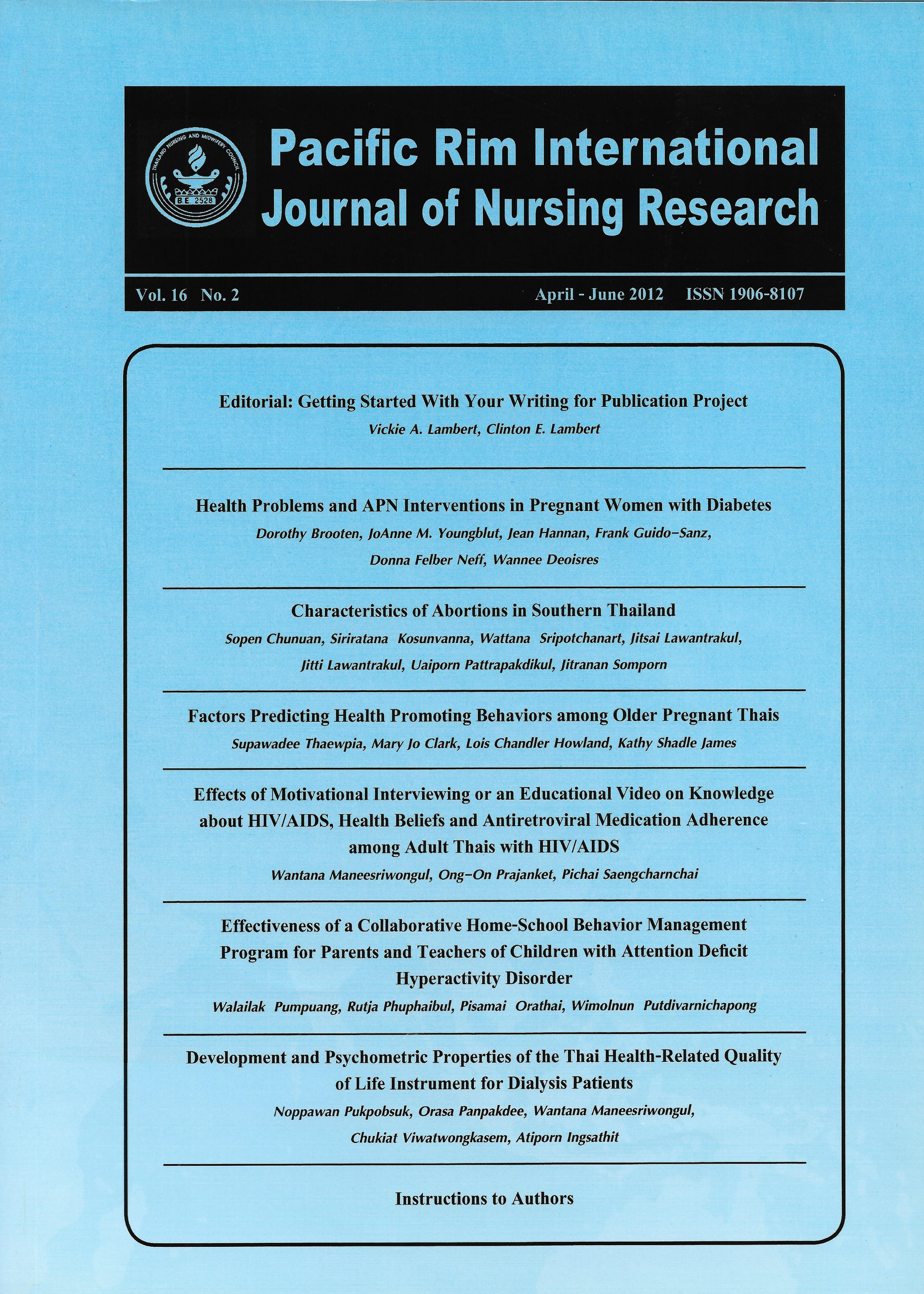Health Problems and APN Interventions in Pregnant Women with Diabetes
Keywords:
การบริการพยาบาลของผู้ปฏิบัติการพยาบาลขั้นสูง, ระบบบริการสุขภาพ, หญิงตั้งครรภ์ที่เป็นเบาหวาน, APN interventions, Health care services, Diabetes in pregnancyAbstract
วัตถุประสงค์ของการศึกษานี้ เพื่อเปรียบเทียบปัญหาสุขภาพและการบริการพยาบาลที่ได้รับจากผู้ปฏิบัติการพยาบาลขั้นสูงในหญิงตั้งครรภ์ที่เป็นเบาหวานสองกลุ่ม จำนวน 41 คน ออกแบบการวิจัยโดยวิเคราะห์เนื้อหาจากบันทึกปฏิสัมพันธ์ของกระบวนการที่ผู้ปฏิบัติการพยาบาลขั้นสูงให้การดูแลหญิงมีครรภ์เหล่านี้ในโครงการวิจัยเชิงทดลอง 2 โครงการ คือ โครงการแรก เป็นการดูแลของผู้ปฏิบัติการพยาบาลขั้นสูง เพิ่มเติมจากการดูแลของแพทย์ (n = 22) ส่วนโครงการที่สอง เป็นการดูแลที่ผู้ปฏิบัติการพยาบาลขั้นสูงดูแลหญิงตั้งครรภ์ทดแทนแพทย์ จำนวนครึ่งหนึ่ง (n = 19) ปัญหาสุขภาพและการบริการพยาบาลของผู้ปฏิบัติการพยาบาลขั้นสูง ได้ถูกจัดหมวดหมู่โดยใช้ระบบของโอมาฮา อายุเฉลี่ยของหญิงตั้งครรภ์ คือ 30 ปี ส่วนใหญ่เป็นคนผิวดำ สำเร็จการศึกษาในระดับมัธยมศึกษาและรายได้น้อย
ผลการวิเคราะห์ พบจำนวนปัญหาสุขภาพทั้งหมด 61,004 และจำนวนบริการการพยาบาลที่ได้รับจากผู้ปฏิบัติการพยาบาลขั้นสูง 60,980 ผู้ปฏิบัติการพยาบาลขั้นสูงในกลุ่มที่สองที่ดูแลทดแทนแพทย์ครึ่งหนึ่ง ให้การบริการพยาบาลแก่หญิงตั้งครรภ์ก่อนคลอดสูงกว่าในกลุ่มแรก ที่เป็นการดูแลเพิ่มเติมจากแพทย์อย่างมีนัยสำคัญทางสถิติ จำนวนปัญหาสุขภาพของหญิงตั้งครรภ์ที่เป็นเบาหวานทั้งสองกลุ่มไม่แตกต่างกัน การบริการพยาบาลโดยผู้ปฏิบัติการพยาบาลขั้นสูงที่มีจำนวนสูงสุด 2 อันดับแรกทั้งก่อนคลอดและหลังคลอด คือ การเฝ้าระวัง การสอนและให้คำปรึกษา ส่วนการจัดการรายกรณีเป็นการดูแลที่พบสูงสุดเป็นอันดับสาม ในขณะที่การรักษาและการทำหัตถการเป็นการบริการพยาบาลที่พบต่ำสุดในทั้งสองกลุ่มทั้งก่อนและหลังคลอด เมื่อผู้ปฏิบัติการพยาบาลสูงร่วมให้การดูแลหญิงตั้งครรภ์ที่เป็นเบาหวานเท่าๆ กับแพทย์ ทั้งชนิดและจำนวนของการบริการพยาบาลจะแตกต่างจากเมื่อผู้ปฏิบัติการพยาบาลขั้นสูงดูแลเพิ่มเติมจากการดูแลของแพทย์ ทักษะที่กว้างขวาง และความเข้าใจอย่างลึกซึ้งในการปฏิบัติทางคลินิก ระบบสุขภาพประเด็นปัญหาของหญิงตั้งครรภ์ที่เป็นเบาหวานและของครอบครัวช่วยให้ผู้ปฏิบัติการพยาบาลขั้นสูงให้บริการการพยาบาลอย่างมีประสิทธิภาพตั้งแต่เนิ่นๆ
The purpose of this study was to compare health problems and advancedpractice nursing (APN) interventions in two types of APN care provided to 41 childbearingwomen with diabetes. The study’s design involved content analysis of interaction logscontaining the process of APN care during two clinical trials: 1) APN care was addedto physician care (n = 22); and, 2) half of physician care was substituted with APN care(n = 19). Women’s’ health problems and APN interventions were classified using the OmahaSystem’s Problem Scheme and Intervention Scheme. The women, in the study, had a meanage of 30, and were predominantly Black, high school graduates, with a low income.
The findings identified 61,004 health problems and 60,980 APN interventions fromthe interaction logs. APNs provided significantly more interventions antenatally to thewomen in the substitution group than to those in the additive group. However, the overallcategories of problems were the same in both groups. Surveillance and health teaching/counseling were the top APN interventions antenatally and postpartum. Case managementinterventions were third most common for both groups, while treatments and proceduresconstituted the least number of APN interventions in each group before and after birth. When APNs shared care more equally with physicians, they intervened differentlyin type and number of interventions. Their broad range of skills and depth of understandingin clinical practice, health systems, family and personal issues allowed them to interveneearly and effectively.
Downloads
How to Cite
Issue
Section
License
Copyright: The Pacific Rim International Journal of Nursing Research, Thailand Nursing & Midwifery Council has exclusive rights to publish, reproduce and distribute the manuscript and all contents therein.








.png)



